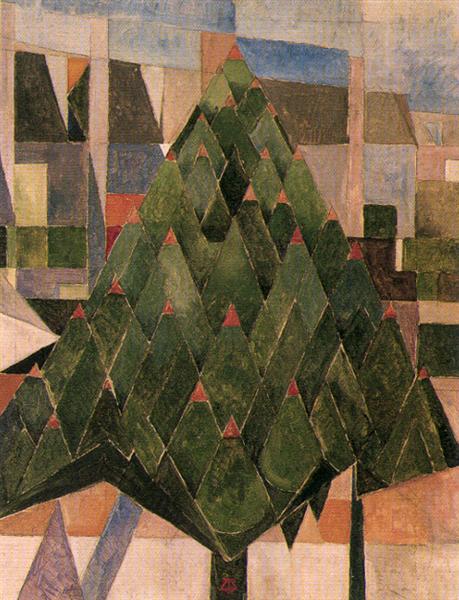Description
The "Tree" work of Theo Van Doesburg, carried out in 1916, is part of the context of the artistic avant -garde of the early twentieth century, a period in which numerous currents sought to break with the conventions of traditional art. Van Doesburg, as one of the main exponents of neoplasticism, a movement founded by Piet Mondrian, was characterized by its search for pure visual expressions, often reduced to basic geometric shapes.
In "tree", the viewer is confronted with a stylized representation of a tree that, far from any romantic idealization of nature, is presented with a geometric approach. The work consists of a network of lines and a scheme of primary and secondary colors, where red, blue and yellow, intertwined with more neutral tones such as black and white predominate. This color use not only highlights the figure of the tree, but also suggests a dynamic tension between forms, evoking a sense of movement and life.
The "tree" composition is characterized by the synthetic fillet of lines that make up the structure of the tree, allowing the viewer to reflect on its significance beyond simple representation. By eliminating superfluous details, Van Doesburg not only reduces the image to its essential elements, but also invites a deeper reading about the relationship of the human being with nature. The tree, a symbol of growth and resilience, is presented in an abstract context that emphasizes its existence as form and color rather than as a natural entity.
In terms of similarity with other works of his time, "tree" can be related to a series of works by other neoplastic artists, where formal reduction and chromatic harmony predominate. However, Van Doesburg's interpretation seems to move towards a directionality and a particular rhythm that distinguishes it. Observing this work is to enter a space where nature is decomposed and reensambated under the principles of abstract art, reflecting the spirit of renewal of the time.
It is important to mention that, although there are fewer documentary data on "tree" compared to other more iconic works by the author, its essence encapsulates the change of paradigm that was brewing in the artistic practice of its time. Through its radical approach and its disdain towards naturalism, Van Doesburg contributes significantly to the conversation about how we perceive the surrounding environment. In "tree", each line and each color becomes an invitation to reconsider not only the object represented, but also the means and intentions behind its creation, thus reaffirming the role of art as a vehicle of experimentation and cultural transformation.
KUADROS ©, a famous paint on your wall.
Hand-made oil painting reproductions, with the quality of professional artists and the distinctive seal of KUADROS ©.
Art reproduction service with satisfaction guarantee. If you are not completely satisfied with the replica of your painting, we refund your money 100%.

